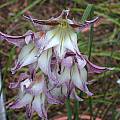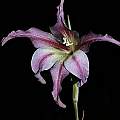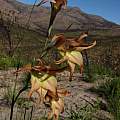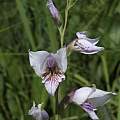From pale rose and mauve to salmon to screaming pink, this color complex offers many shades and the widest range of species in the color indices.
Page 1: G. anatolicus... Page 2: G. carmineus... Page 3: G. densiflorus... Page 5: G. maculatus... Page 6: G. nigromontanus... Page 7: G. phoenix... Page 8: G. saxatilis... Page 9: G. vernus...
Gladiolus gracilis Jacq. is very similar to Gladiolus caeruleus, but is a bit smaller, has fewer flowers (2 to 5 in a spike), is usually blue to grey, but occasionally pink or yellowish and has dark streaks (instead of spots) on the lower tepals. The lowermost tepal is usually longer in this species instead of mostly the same length as the others in G. caeruleus. It is found mostly on clay slopes (or granite) and blooms in winter. The first two photos were taken by Alan Horstmann. The third was taken by Mary Sue Ittner March 2004 of flowers grown from Silverhill Seed and the fourth in 2007 of more seed grown plants, but this time one with pink flowers. The last photo was taken by Bob Werra
The photos below were taken by Nhu Nguyen of a plant from Telos Rare Bulbs.
All of the pictures below were taken by Cameron McMaster near Napier in the Overberg and illustrate the different forms possible.
The photos taken by M. Gastil-Buhl show seeds from Silverhill Seed dry on a 1 mm grid, then wet.
Gladiolus gueinzii Kunze grows on coastal sand dunes at and above the high tide mark in the southern Cape where it occurs in both the winter and the summer rainfall areas. It produces small cormlets around the base of the buried corm like other species, but also produces a large glossy dark corm that is bouyant in the water and is dispersed to new areas by floating. Growing from 25 to 50 cm high, this species has four to eight mauve flowers with red-purple and white markings on the lower tepals. It flowers in late spring to summer. The first photo was taken by Rachel Saunders. The second photo was taken on the Otter Trail by Andrew Harvie.
Photos from Paul Sieben who comments: "The first photo reflects how close to the sea they grow and flourish. The base of the dune would have been cut by the past equinox spring tides. The second shows how big the pods are and how full they are relative to the flower. All the flowers I have seen have been very similar to the one that Andrew Harvie took (above), they hardly open. The abundance of seed and plants could be due to the closure of our beaches (in 2020) and a lengthy lockdown period here in SA, far less trampling of the dune area as this is at a popular access point".
Photo 3 shows how offset bulbs form around the base of the stem and result in clusters of plants.
In September 2023 "We have had extreme storm surges associated with Spring equinox tides which has stripped the coast of sand exposing the bulbs. This shows the white stem indicating that the bulbs are between 200 and 300 mm below the surface. In my experiences this is very deep for gladioli bulbs, it is possibly to prevent dehydration on the dunes. At least 70 % of the bulbs have been washed away in this one incident".
Gladiolus hirsutus Jacq. has been described under many different names. For a long time it was confused with Gladiolus caryophyllaceus which has larger scented flowers and in the 1972 revision of this genus was named Gladiolus punctulatus but that name is no longer accepted as the correct name. It is widespread in the winter rainfall areas where it is found in a variety of habitats (sandy flats, mountain slopes, rocky outgroups), usually in sandstone or granite soils. It is pink to purple or white with darker streaking on the lower three tepals. The leaves are very hairy, hence the name. The first two photos were taken by Bob Rutemoeller and Mary Sue Ittner in the southwestern Cape in September 2001 in an area that had burned the year before. The next two by Mary Sue Ittner were taken in August 2006 near the Du Toit Kloof mountain pass where we saw these blooming down the slope when we stopped to look at the view including a close-up of the latter when holding the flower helped to get the plant in focus because it was so windy. The fourth and fifth photos were taken in the Phillipskop Mountain Reserve near Stanford, by Christopher Whitehouse.
More habitat photos from Cameron McMaster from Hermanus and Napier in the Overberg.
Photos by Bob Werra, Mary Sue Ittner, and Alan Horstmann of garden plants.
Gladiolus hollandii L.Bolus grows on lower slopes of mountains and on granite outcrops, often in well drained gritty soil in light to moderate shade in the eastern southern African lowveld (Northern Province, Mozambique, Swaziland). Plants grow from 0.6-1.2 m and have a multi-flowered spike of 18 to 30 and sometimes more pale pink minutely dotted dark pink unscented flowers with a reddish median streak running the length of the tepals. Flowering time is mid February to April. Photos by Rachel Saunders.
Gladiolus inflatus Thunb. grows in open habitats on sandstone, often in rocky outcrops or in stony ground among shrubs and restios in the mountains of the Western Cape. It has pink to mauve, purple or violet short tubed flowers. The lower tepals have dark spear or spade shaped purple to red marks in the middle third. The mark on the lower median tepal is usually yellow in the center. This species blooms in spring. Photo taken by Rod Saunders.
Gladiolus liliaceus Houtt. grows on clay slopes over a wide area of South Africa (from the Cedarberg Mountains to Port Elizabeth) and blooms winter to spring. Growing from 30 to 80 cm high, the 1 to 4, sometimes 6, flowers are an inclined spike. The large flowers are brown, dull pinkish red, tan, purplish or cream to greenish yellow and turn bluish to mauve in the evenings when they become intensely clove scented. Depending on the location and the elevation with the lower elevations blooming earlier, this species blooms from late August to December.
The ones grown by Mary Sue Ittner have not been very fragrant and the color change is subtle. Photo 1 was taken by Mary Sue Ittner. Photos 2-3 from Bob Rutemoeller attempt to show the change in color. Photo 2 was taken during the day and photo 3 in the early evening. Andrew Harvie's photos (4-5) show the orangey red color of the day and the more purple color of the night. To ensure correct color balance both photos were taken with a flash and same exposure. He notes that he wishes he could also share the fragrance.
The forms pictured below in the first four photos were all found at Drayton and were blooming August-September 2003. Photos by Bob Rutemoeller including a single yellow one. The fifth photo is of a red flowered one photographed by Cameron McMaster near Bredasdorp in the Overberg. The last photo from the book Plants of the Klein Karoo courtesy of Jan and Anne Lise Schutte-Vlok.
Gladiolus loteniensis is a narrow endemic known only from the upper Loteni River valley in KwaZulu-Natal. It grows in flat sites along the riverbank in black peaty soil and in the lee of low cliffs or boulders. Growing from 30 to 60 cm high, it has 4 to 7 leaves. The lower and longest basal leaves are narrowly lanceolate to linear with a lightly thickened and raised midrib and the remaining leaves are inserted between the middle and upper quarter of the stem and are channelled. Flowering occurs early December to mid January with a straight to slightly flexed spike of 6 to 12 unscented pale lilac short tubed flowers. The lower three tepals are veined violet on a cream to pale yellow background in the lower two thirds; the upper third is pale or dark lilac. Photos taken by Rachel Saunders December 2014.
Gladiolus macneilii Oberm. is a narrow endemic of the eastern escarpment of northern Mpumalanga, South Africa where is grows in loamy soil in rocky ground in grassland and light woodland. Growing from 70 to 90 cm with a slightly inclined spike of 7 to 17 flowers, it blooms in March and April. Flowers have a very long perianth tube (40 to 45 mm) and are cream to pale salmon pink, each with a narrow, dark red, longitudinal median streak. The upper three tepals are the largest with the dorsal tepal arching over the stamens and the lower three tepals are united at the base with narrow and recurving tips. The anthers have short appendages and long purple tails. Photos by Rachel Saunders.
Page 1: G. anatolicus... Page 2: G. carmineus... Page 3: G. densiflorus... Page 5: G. maculatus... Page 6: G. nigromontanus... Page 7: G. phoenix... Page 8: G. saxatilis... Page 9: G. vernus...


























































